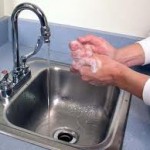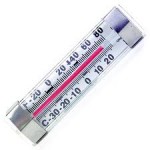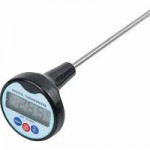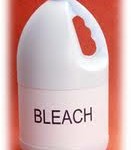The Top 5 Tips to Keep Your Family Safe in Your Home Kitchen
This evening I’m giving a presentation to the Council of Independent Managers at The Madison Club. I thought I’d share one of the topics I’ll be discussing here on the blog: How can we ALL be more safe in our OWN kitchens?
How safe is your kitchen?
What grade would I give it if I came and did a private health inspection?
The FDA estimates that there are about 48 million cases of foodborne illness annually –that’s 1 out of 6 Americans getting sick each year. These illnesses result in an estimated 128,000 hospitalizations and 3,000 deaths every year. That means 60 people in each of our 50 states will die this year just from something they ate!
Here are the top priorities restaurants have in place, and the ones YOU should too, to keep your family safe?
#1 Wash Your Hands (before, between & after prep)
Wash your hands with warm water and soap for at least 20 seconds before and after handling food and after using the bathroom, changing diapers, sneezing, handling pets, handling raw meat, smoking, eating or basically touching anything besides the food you are prepping.
#2 If You are Sick, Stay Out of the Kitchen & Away from Work
Do NOT prepare food when you are sick (i.e., you have diarrhea, fever, vomiting, open sores, or persistent cough/sneezing/runny nose). Yes it’s gross to say….it’s even grosser to be around others and food with these conditions…you’re a walking, coughing petri dish- back in the day my grandma and mom got quarantined in their homes for this stuff! Stay in bed, away from others and out of the kitchen.
#3 Wash Surfaces
Wash your cutting boards, dishes, utensils and with hot soapy water after preparing each food item and before you go on to the next food.
Consider using paper towels to clean up kitchen surfaces. If you use a dish cloth to wash dishes and wipe counter tops, it’s a good idea to keep the cloth in hot soapy water while you are prepping, change it often and place it in a manner that allows it to dry quickly between uses. Bacteria can grow on a warm cloth that has not been sanitized or washed often. DO NOT use a sponge on your dishes or counter tops-they are like an all-inclusive resort for bacteria!
Wipe counter tops and surfaces with a homemade bleach solution ( or a similar commercial product)- especially if anyone in your house is sick. To make, dilute 1 ounce of bleach in 1 gallon of water. This is great for the bathroom too! Remember, bleach is the only thing that kills stubborn viruses! It’s your cheapest and best defense against them.
#4 Proper Cooling & Cold Holding of Foods
Improper cooling is one of the number one causes of foodborne illness. If food is not cooled fast, it remains in what’s called “the temperature danger zone” too long. At room temperature, foodborne illness causing bacteria can double every 20 minutes! Chilling foods to proper temperatures is one of the best ways to slow the growth of these bacteria.
It can be very difficult to cool food quickly because most refrigeration units are not designed or capable of this. Do not over-stuff the refrigerator. Cold air must circulate to help keep food safe.
Place food in shallow containers and leave them uncovered in your refrigerator to cool.
Invest in an inexpensive appliance thermometer and keep it in your refrigerator so you can always be sure the temperature is consistently 40˚F. Keeping a constant refrigerator temperature of 40ºF or below is one of the most effective ways to reduce the risk of foodborne illness.
#5 Proper Preparation & Disposal of Foods
Do not thaw or marinate on the counter. Thaw in the refrigerator or in submersed in cold water.
Get your food from the grocery store or leftovers from the restaurant home quickly.
Raw produce must be washed thoroughly. Melons must be washed before being sliced.
Cook to the right temperatures. Food is safely cooked when it reaches a high enough internal temperature to kill the harmful bacteria  that cause illness. Another great minor investment- a digital food thermometer to measure the internal temperature of cooked foods! Use this each time you need to check the internal temperature of food your are cooking or cooling. Check in several places to make sure that the temperature it is where it needs to be for the task you are performing and meat you are cooking (ref the FDA Safe Cooking Temperature Chart).
that cause illness. Another great minor investment- a digital food thermometer to measure the internal temperature of cooked foods! Use this each time you need to check the internal temperature of food your are cooking or cooling. Check in several places to make sure that the temperature it is where it needs to be for the task you are performing and meat you are cooking (ref the FDA Safe Cooking Temperature Chart).
Throw food out if it is over 7 days old. Put a date on it when you first put it in the frig if you have a hard time remembering. When in doubt, throw it out!! Don’t rely on taste or smell. Bacteria and viruses are tricky that way!


